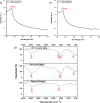Sustainable fabrication of dimorphic plant derived ZnO nanoparticles and exploration of their biomedical and environmental potentialities
- PMID: 38862646
- PMCID: PMC11167042
- DOI: 10.1038/s41598-024-63459-0
Sustainable fabrication of dimorphic plant derived ZnO nanoparticles and exploration of their biomedical and environmental potentialities
Abstract
Although, different plant species were utilized for the fabrication of polymorphic, hexagonal, spherical, and nanoflower ZnO NPs with various diameters, few studies succeeded in synthesizing small diameter ZnO nanorods from plant extract at ambient temperature. This work sought to pioneer the ZnO NPs fabrication from the aqueous extract of a Mediterranean salt marsh plant species Limoniastrum monopetalum (L.) Boiss. and assess the role of temperature in the fabrication process. Various techniques have been used to evaluate the quality and physicochemical characteristics of ZnO NPs. Ultraviolet-visible spectroscopy (UV-VIS) was used as the primary test for formation confirmation. TEM analysis confirmed the formation of two different shapes of ZnO NPs, nano-rods and near hexagonal NPs at varying reaction temperatures. The nano-rods were about 25.3 and 297.9 nm in diameter and in length, respectively while hexagonal NPs were about 29.3 nm. The UV-VIS absorption spectra of the two forms of ZnO NPs produced were 370 and 365 nm for nano-rods and hexagonal NPs, respectively. FT-IR analysis showed Zn-O stretching at 642 cm-1 and XRD confirmed the crystalline structure of the produced ZnO NPs. Thermogravimetric analysis; TGA was also used to confirm the thermal stability of ZnO NPs. The anti-tumor activities of the two prepared ZnO NPs forms were investigated by the MTT assay, which revealed an effective dose-dependent cytotoxic effect on A-431 cell lines. Both forms displayed considerable antioxidant potential, particularly the rod-shaped ZnO NPs, with an IC50 of 148.43 µg mL-1. The rod-shaped ZnO NPs were superior candidates for destroying skin cancer, with IC50 of 93.88 ± 1 µg mL-1 ZnO NPs. Thus, rod-shaped ZnO NPs are promising, highly biocompatible candidate for biological and biomedical applications. Furthermore, both shapes of phyto-synthesized NPs demonstrated effective antimicrobial activity against various pathogens. The outcomes highlight the potential of phyto-synthesized ZnO NPs as an eco-friendly alternative for water and wastewater disinfection.
Keywords: Anti-skin cancer; Antimicrobial; Antioxidants; Green synthesis; Halophyte; Mediterranean region.
© 2024. The Author(s).
Conflict of interest statement
The authors declare no competing interests.
Figures









Similar articles
-
In vitro antioxidant and antibacterial activities of biogenic synthesized zinc oxide nanoparticles using leaf extract of Mallotus philippinensis Mull. Arg.Sci Rep. 2025 Feb 24;15(1):6541. doi: 10.1038/s41598-025-85264-z. Sci Rep. 2025. PMID: 39994261 Free PMC article.
-
Biosynthesis of zinc oxide nanoparticles using Albizia lebbeck stem bark, and evaluation of its antimicrobial, antioxidant, and cytotoxic activities on human breast cancer cell lines.Int J Nanomedicine. 2018 Dec 20;14:87-100. doi: 10.2147/IJN.S186888. eCollection 2019. Int J Nanomedicine. 2018. PMID: 30587987 Free PMC article.
-
Eco-friendly synthesis of ZnO nanoparticles fabricated using Fioria vitifolia L. and their biomedical potentials.Microb Pathog. 2025 Feb;199:107139. doi: 10.1016/j.micpath.2024.107139. Epub 2024 Nov 22. Microb Pathog. 2025. PMID: 39579945
-
Green synthesized ZnO and ZnO-based composites for wound healing applications.Bioprocess Biosyst Eng. 2025 Apr;48(4):521-542. doi: 10.1007/s00449-024-03123-z. Epub 2024 Dec 31. Bioprocess Biosyst Eng. 2025. PMID: 39739126 Review.
-
Eco-friendly zinc oxide nanoparticle biosynthesis powered by probiotic bacteria.Appl Microbiol Biotechnol. 2025 Jan 29;109(1):32. doi: 10.1007/s00253-024-13355-4. Appl Microbiol Biotechnol. 2025. PMID: 39878901 Free PMC article. Review.
Cited by
-
Synergistic Antibacterial and Antibiofilm Effects of Clindamycin and Zinc Oxide Nanoparticles Against Pathogenic Oral Bacillus Species.Pathogens. 2025 Feb 2;14(2):138. doi: 10.3390/pathogens14020138. Pathogens. 2025. PMID: 40005514 Free PMC article.
References
-
- Albrecht MA. Green chemistry and the health implications of nanoparticles. Green Chem. 2006;8:417–432. doi: 10.1039/b517131h. - DOI
-
- Ashraf H, et al. Comparative evaluation of chemically and green synthesized zinc oxide nanoparticles: Their in vitro antioxidant, antimicrobial, cytotoxic and anticancer potential towards HepG2 cell line. J. Nanostruct. Chem. 2022 doi: 10.1007/s40097-021-00460-3. - DOI
-
- Alamier, W. M., Hasan, N., Ali, S. K. & Oteef, M. D. Y. Biosynthesis of Ag nanoparticles using Caralluma acutangula extract and its catalytic functionality towards degradation of hazardous dye pollutants. Crystals (Basel)12, 1096 (2022).
-
- Mahmoud AED. Eco-friendly reduction of graphene oxide via agricultural byproducts or aquatic macrophytes. Mater. Chem. Phys. 2020;253:123336. doi: 10.1016/j.matchemphys.2020.123336. - DOI
MeSH terms
Substances
LinkOut - more resources
Full Text Sources

